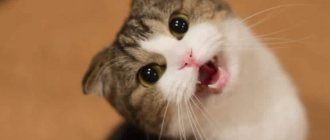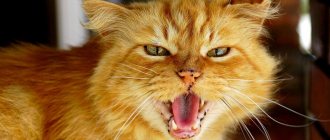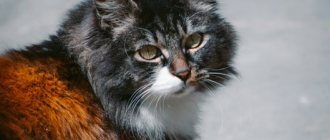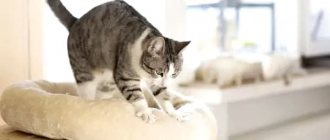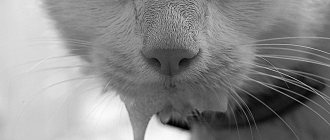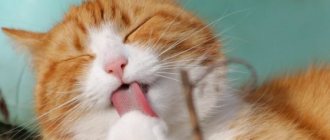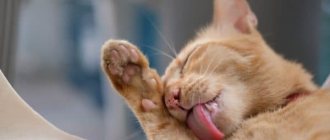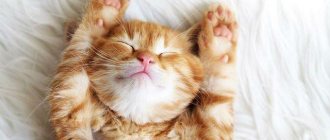Purring phenomenon
Throughout the history of mankind, the cat has accompanied us. Tens of thousands of years ago, the inhabitants of the Middle East tamed the wild steppe cat, and since then it has become a symbol of the hearth and home.
Due to its special unusual sound, in ancient times this animal was a symbol of fun and play, but in the Middle Ages the mysterious essence of purring began to be considered devilish and sinful.
Modern cat lovers know that their songs are not sent from heaven or hell, but are the result of a physiological process. It is not entirely clear which organ is responsible for sound; only one thing is clear – sounds are produced consciously and controlled by the animal itself.
Physicists have discovered that a cat's body emits electromagnetic impulses that produce loud or quiet sounds. They are beneficial for animals and humans, have a healing effect and bring peace and tranquility to the atmosphere of the home.
What does a cat's purring mean?
Previously, it was believed that this is how animals communicate with each other and humans when they are stroked. However, “mur-mur-mur” is not only a means of communication and a way to express pleasure.
Method of communication
Kittens begin to purr already in the first days after birth. This is how they help mom find herself and feed her. With a person, everything works about the same. Animals wake people up, butt and purr loudly in the morning, especially if they spend the night in another room. “Good morning, master! It’s time to get up and feed me.” If your pet loudly “sings songs” in the kitchen (or where you usually feed your pet) and curls under your feet, meowing periodically, this is a direct hint of a desire to snack.
Surely you have noticed more than once that pets greet you stormily from work. At this moment, you can also hear a joyful “mrrr”.
Purring, the cat greets its human.
In relation to relatives, everything works exactly the same: a quiet sound indicates location. He warns others about a benevolent and good-natured attitude. This is also how animals encourage each other. Some scientists have noticed that wounded cats lie down next to each other.
Expression of pleasure
A satisfied cat - what could be more pleasant for the owner? Pets can actually express pleasure and even gratitude from tasty food, a secluded bed and warmth. Many pets love affection, and with the help of purring they express pleasure from stroking and scratching.
In combination with paw stomping, purring indicates peace and love. This means that your pet completely trusts you, is happy and feels as calm as she does next to her mother. After all, kittens’ little paws make “massage” movements to get more milk. Apparently, the memory remains with the animal forever, and pops up in moments of good mood. And besides, in this way the cat “marks” the owner.
Connection with nutrition
Remember that a kitten purrs so that the cat notices and feeds it? Echoes of this mechanism can be seen in the fact that many animals rumble when they eat. Perhaps from pleasure. Especially if it is SUPERPET - a species-typical food for cats and dogs according to the BARF system, developed by veterinarians and nutritionists. It replicates the diet of predators in nature: 98% consists of raw meat without heat treatment, flavor enhancers and preservatives. Biologically appropriate nutrition normalizes digestion, prevents urolithiasis, kidney disease and other ailments. And how delicious it is! Pets can only purr with pleasure.
The mechanism of sound production when purring
Some scientists put forward their theories about the source of rumbling, offering the following options.
Vocal cords are used by cats to meow, which humans hear when the animal makes the sound with its mouth open. If it is closed, then the vibration, which occurs due to the same work of the ligaments and throat, touches a special bone located under the tongue.
The sinuses increase vocal resonance. When an animal's mood changes, the speed of blood flow increases, that is, a change in blood pressure occurs. Vibration of the chest causes vibrations, which are converted into sound in the sinuses.
The involvement of the lungs in the process was established through observation of animals: purring is not the same when inhaling and exhaling.
How does this happen and where does the sound come from?
It may seem a little ridiculous, but the mystery of a cat's purring has not yet been solved. Scientists around the world have put forward various assumptions about the origin of the cute sound. However, none of them have been proven. Zoologists are still arguing why a cat purrs and in what way.
Photo: There are many theories about the origin of cat purring
The problem is that the organ responsible for the rhythmic iridescent sounds both during exhalation and inhalation is currently unknown.
There is a version that the chirping is created due to the peculiar vibrations of the very fragile hyoid bones located near the vocal cords. Unfortunately, it was not possible to test the hypothesis.
Some felinologists believe that purring is caused by increased circulation in the blood vessels caused by the cat's emotional experiences.
This causes the chest to vibrate. and the throat of the animal. The vibrations are then transmitted to the head and resonate in the cranial sinuses.
Photo: Some theories about cat purring aren't very scientific
In ancient times, there was a misconception that cats allegedly purr with their stomachs. It is unclear how exactly such a strange theory was explained, but it spread widely among people.
There is an assumption that sound vibrations occur in the animal’s lungs during rapid inhalation and exhalation. The air inside the organs begins to vibrate, emitting a bizarre soothing “purr”.
A group of scientists believes that the cat makes such unusual sounds using rhythmic movements of the larynx.
Another assumption is based on the fact that special contractions of the cat’s diaphragm generate purring.
There is a theory that such sounds cause powerful impulses emanating from the pet’s brain.
These charges travel through the central nervous system to the muscles of the vocal cords and activate them. The vibration of the latter during inhalation and exhalation is heard by us as a purr.
But scientists from New Orleans used powerful microphones to find false vocal cords in cats. They are quite soft and elastic, which allows them to vibrate strongly and make chirping sounds.
Are only cats able to purr?
It is widely believed that purring is a privilege of the feline family. Indeed, each of its members, regardless of size, can make similar sounds, but in large representatives they are more like a roar and roar.
However, there are many species in the animal kingdom that have a similar ability. For example, species related to cats are cat-like hyenas and civets: mongooses, genets, civets. In a good mood, foxes and badgers, guinea pigs and squirrels purr while eating. Gorillas and sometimes even elephants rumble quite loudly.
Cats communicate using purring
Often, purring sounds help the cat family communicate with each other. The quiet purring of cats indicates that they are friendly towards the animal and encourage it to become a participant in their games. A loud purr positions the cat as a strong, dominant animal. Thus, a cat can show its relative that it is stronger, so it is pointless to engage in battle with it; it also means that a weaker cat need not be afraid, since no one will attack it. Purring sounds can also indicate that the cat is completely defenseless and asks not to be harmed.
With the help of purring, cats can heal each other , so it was noticed that if one of the felines feels bad or is sick with something, another cat comes and purrs, calming and encouraging him.
No less interesting is observing the relationship between a cat and her cubs. Kittens, by purring, give a signal to the mother cat that they want to eat or have eaten and are now completely full. Particularly funny are the moments when kittens eat their mother's milk and quietly purr with pleasure. Hearing their mother purr, the kittens feel completely safe while eating milk. Purring is a mother's signal when she is approaching the den of her cubs. By purring, she lets the kittens know that everything is fine and they don’t have to worry about anything, because mom is already nearby.
Causes
The first reason is pleasure. Kittens purr from warmth and satiety, adult cats purr from the affection of their owner. Animals show it not only by sound, but also, for example, by releasing their claws.
In addition, there are a number of other factors that can trigger purring:
- Demand for attention.
- Request for food.
- Relieving stress and pain, for example, during childbirth or severe wounds, fear.
- Expression of gratitude.
- Acquaintance.
- The joy of hunting.
Cat massage
There are many guesses why the pet purrs and tramples its owner with its paws. Here are some of them:
- Memories of childhood, or “milk step” - kittens knead their mother with their paws while feeding to quickly obtain milk. This brings them pleasure and is associated in adults with a feeling of comfort, satiety and security.
- Prepares a comfortable place to sleep - tramples the surface on which you are going to sleep for the greatest comfort. The owner's knees may well be suitable for this purpose.
- Gratitude - in this way one can say “thank you” for delicious food, warm shelter, tenderness and affection.
- Therapeutic massage is a common theory that this is how a cat treats its owner from ailments.
- Stress relief – by purring and moving their paws, cats lift their spirits, relax and calm down.
- Unfulfilled sexual instinct - one theory says that if an animal does not have a mate, it may show unambiguous interest.
- Marks its property - cats have glands on their paw pads that secrete a secretion. This is one of the ways to convey to other animals that a person belongs to him.
- Showing trust and love - the pet shows its owner its location, favor, openness and trust. Emphasizes your closeness with a person.
This massage soothes, relaxes and helps relieve stress. But what if claws are used? You can lightly press the cat towards you so that he lies down and stops trampling. You should not scold or drive out an animal if its trust and peace of mind are valuable. It’s better to just put a blanket or pillow on your knees in advance.
Reference! A cat will reflexively retract its claws if you stroke the top of its paws.
Scientists' opinion
Zoologists believe that the occurrence of purring is primarily associated with motherhood. With this sound, the mother calms the babies, lets them know that she is nearby, and can also warn of danger.
In addition, researchers from the American Stanford Institute found that purring helps strengthen bones.
A pet's sedentary lifestyle, which spends most of the day sleeping, does not affect the health of the musculoskeletal system precisely because of this ability: vibration restores musculoskeletal activity.
Why does he purr when you pet a cat?
Don't be surprised if you pet your cat for a long time and he will start purring. This is connected precisely with receiving positive emotions. The animal likes such stroking, it calms it down. Accordingly, the cat makes a characteristic sound. Sometimes pets can come to their owners, lie down next to them and purr for no apparent reason, even if you don’t pet them. This is connected precisely with the desire to improve health.
Often cats lie down near the area that is sore. Perhaps these are chronic diseases. It is at such places that cats lie down, lean against them and purr. In this way they try to cure their owner. A cat may purr for the simple reason that it is hungry or wants to go for a walk. Accordingly, in this case, the nature of the purring will be different.
Petting the cat
Purring as communication
Depending on the timbre and volume, the purring of one cat may indicate a demonstration of a social role in front of another. A quiet purr speaks of friendly and peaceful thoughts: for example, a cat thus shows the cat its defenselessness. Loud is a manifestation of dominance.
Many owners note that if someone in the house is sick, the cat will certainly purr supportively over the sick person.
A person is perceived by a pet as an equal member of the pack. A purring pet shows the household its affection, gratitude, or asks for affection. If a cat with a raised tail purrs loudly and sparkles its eyes at a guest or a new thing, this means a demonstration of hostility.
The benefits of a cat's purring for humans
Our smaller furry brothers are real doctors. There is even feline therapy - treatment by communicating with cats. Pet owners cope better with stress, are less likely to become depressed, are more sociable and, in general, are healthier than people without pets. Why is purring useful?
Cats are furry physiotherapists. At a frequency of 25-50 Hz, bone tissue responds to purring, and at 100 Hz, skin and soft tissues respond. It's not as crazy as it may seem: the body's tissues respond to pressure by becoming stronger. Scientists even propose using this property of vibration for astronauts so that their bones do not lose their density in zero gravity.
A purring cat pleases the human heart. This means that having a pet in the home reduces the likelihood of having a stroke by a third. “Pur-mur-mur” is a kind of white noise, to which the owner calms down and falls asleep more easily.
Thus, not all purring kittens and cats are happy with their situation. A purring pet can feel both joy and pain. This amazing means of communication allows animals to communicate with each other and get what they want from humans. If a cat likes food or, conversely, is hungry, it will purr. This is done by domestic purrs, cheetahs, and pumas. But if your pet does not want to purr, this is also not a problem, and you can do nothing about it.
Author of the article
Yulia Antonovskaya
Lyricist
Rate this article
- 5
- 4
- 3
- 2
- 1
0
votes, average:
0 out of 5
Purring as a stress reliever
Veterinarians say that the process of purring helps a cat cope with pain. Vibration relieves tension from the muscles, from which blood flows to the brain, which helps to quickly calm the pet.
For example, cats purr especially intensely during childbirth. This helps them not only calm down, but also breathe correctly.
If the owner needs to provoke purring, it is recommended to stroke the area of the neck, belly, and back.
Educational facts
- Some people explain the purring mechanism with other versions. For example, such a sound creates a kind of air flow in the lungs and blood circulating in the veins in a special way, which is subsequently converted into sounds in the head.
- It has been found that certain breeds of cats purr more often than others, while others purr less often. For example, Siamese and Thai breeds are considered to purr most often, and breeds such as Devon Rex and Ragdoll are considered the least likely.
- If your cat used to purr often, but now for some reason has stopped, then you should think about whether he is comfortable and cozy. Perhaps the cat is showing his resentment or dissatisfaction with something.
- Many people, thanks to a cat's purr, seem to calm down and relax. There is an assumption that cats are capable of treating people with their vibrations, for example, from hypertension.
- Even cats that are deaf from birth can purr.
- It is worth noting an interesting fact that the vibration of the purring sound spreads throughout the cat’s body, so during this process it is impossible to listen to the heartbeat and breathing. In order for the purring to stop, they usually turn on the water, since the sound is very alarming to the cat, and it becomes distracted.
The therapeutic effect of purring
Experienced owners say that cats sense illness, and if the pet always sits on its stomach or chest, you should consult a doctor.
Psychologists distinguish such a concept as feline therapy - a method of treating or preventing various diseases through contact with a cat. Its effectiveness has been confirmed by numerous experiments.
Thus, American scientists have found that when a cat purrs, a person’s blood pressure and pulse normalize. And Russian zoologists have found that cat owners, according to statistics, live several years longer and suffer 20% less from problems with the cardiovascular system.
Today, feline therapy is especially popular for the treatment of diseases such as depression, anxiety, irritability and stress, and migraines.
Why your cat doesn't purr and what to do about it
Is it possible to make a cat purr? No, especially if she is not naturally inclined to do this. And that's okay: not everyone feels the need to express emotions by purring. There are even breeds that are not inclined to turn on their “engines” - Ragdolls and Devon Rex. Here, again, there are exceptions.
Getting a purr to do anything is very difficult in general, and with purring and other ways of expressing emotions it is even more difficult. This partly explains the impossibility of accurately diagnosing the mechanics of the appearance of iridescent sounds in predators. Nobody wants to purr in an MRI machine or during an ultrasound.
Sometimes this “insensitivity” is related to previous negative experiences. If the cat has been with bad owners or on the street, it may simply be afraid to show emotions by purring. You can try to help your cat make the desired sounds. Play with her, caress her, introduce treats into her diet (always natural) and demonstrate by your behavior that you are a safe person.
Mr. Cat recommends: interesting facts
Purring is a process unique to the animal world. But among the purring ones there are their own records:
- The volume of the rumbling varies in the range from 16 to 100 dts.
- The English cat Merlin purrs four times louder than an ordinary pet. The sound is so loud that it drowns out a running hair dryer. Eyewitnesses compare the cat's purring to the sound of a landing plane.
- The kitten makes its first “murr” at the age of two days.
- The most “purring” country in the world is Australia, where there is a cat for every resident.
1111
Ways to understand your pet
Each animal has an individual character. Additionally, sociability varies by breed. Siamese cats are considered the most talkative. The good-natured British also love to purr. Experts say that the human ear is able to recognize 16 vocal signals that a cat gives. A kitten that has reached the age of 3 months already has a full vocabulary.
To learn how to communicate with your pet, you need to carefully listen to her intonation:
- Purring, similar to a lullaby, usually indicates a benevolent mood, peace, and satiety. In this way the cat shows its good attitude towards its owner.
- Uterine sounds, which may alternate with hissing, mean fear or rage.
- A typical greeting for pets is a single or multiple meow in high tones, turning into a purr.
- Purring, accompanied by a sharp, demanding meow, can mean a complaint or request: this is how a cat behaves when they are hungry or trying to get a tasty morsel from the owner’s table.
- A loud, prolonged meow accompanied by rumbling is a call for help or a symbol of anger. The cat may be scared or in pain.
Cat emotions and rumbling
There are many emotional states that cause a cat to purr.
The most basic ones are:
- Gratitude. A small pet purrs with pleasure from affection, a treat received, or from being close to its owner.
- Relaxation before bed. When a cat feels safe, relaxingly dozes before bed in the sun or in the arms of its owner, it purrs with pleasure.
- Dialogue between a cat and kittens. The cat, approaching the kittens, purrs, calming them down. In the wild, kittens were often left alone while their parents hunted, and thus the adults warned them that there was nothing to be afraid of.
- Self-medication and treatment. If the cat is sick or one of the pets is sick, it stabilizes the metabolism and blood circulation process due to vibrations. At these moments it is better not to touch the animal.
- Hunting interest. A cat may make purring sounds when playing or watching “game.” This is how she shows her interest.
- Fear and aggression. Many people have watched cats purr before a fight. This is how cats express their dissatisfaction and readiness to attack.
In different situations and different emotional states of the pet, the rumbling has a different tone.
When communicating with other animals, a cat may purr quietly, which indicates its trust. If a cat purrs loudly when meeting other cats, then it shows a leadership position and a readiness to attack. Sometimes purring is a request for mercy if the animal understands that it is weaker than its opponent.
How do cats purr?
Who would have thought that such a seemingly trivial question could plunge “great minds” into complete stupor. Until recently, scientists were simply unlucky: they were unable to unravel the mystery of how and why pets make sounds.
Hypotheses
Some suggested that the whole issue was in the vibration of the diaphragm or trachea, other pundits generally blamed the cat's belly for everything. But the whole point is that it was not possible to solve the puzzle due to the examination of immobilized animals that did not make a single sound.
Interesting facts about cat purring
There are many interesting facts on this topic that few people know:
- There are situations in history when a pet could imitate simple monosyllabic sentences while purring. Of course, this is simple, but this fact is still quite unusual and interesting.
- Cats “talk” only when completely alone or in the presence of a person. If two animals are in the same room, they do not need this type of communication.
- Purring can be beneficial not only for the cat, but also for the owner. The sounds and vibrations of cats when you pet them have a beneficial effect on the human body: headaches, fatigue, apathy go away, even blood pressure can stabilize in some cases.
- When an animal purrs, the veterinarian cannot listen to the heartbeat; it simply cannot be heard. Therefore, doctors wait until the cat calms down or turn on the water to distract him.
It doesn’t matter how loudly or how long the pet “talks”, what matters is that it does it. After all, in this way a cat shows you its love, appreciation and trust. The animal thanks you for feeding, treating and caring for it in general.
Don't drive away the purring cat! Enjoy his “symphony”, relax your nervous system, become calmer, healthier and happier with him!
Learning to purr
But seriously, surround the cat with love and in a moment of peace, lie down next to him and gently stroke him. As soon as the cat begins to purr, the person should, breathing only through his nose, try to tune in to the cat's frequency and try to make a sound as similar as possible to purring. Don't be discouraged if all you get out is grunting at first. Over time, a persistent student will definitely succeed.
Hearing a person purr, the cat will probably feel even more love for him. Well, in the company of your own kind, you can always make a splash! But you can make everyone laugh and surprise, but it’s unlikely that you can heal. This secret knowledge is hardly transmitted along with the purring skill.
So good luck with your studies! And remember: all cats purr at the same frequency - 25 cycles per minute, and nothing else. And finally, a poem!
How can a person learn to purr like a cat?
Having understood the physiology of cats, you can try to transfer this knowledge to the human body. Is it possible to create such sounds with the help of our body? Unfortunately no.
The vocal cords of cats and humans are very different.
A person will never be able to purr like a cat because of the structure of the vocal cords - they are very different. Cats contract the muscles in their larynx, which moves their vocal cords. The process occurs instinctively, unconsciously, and it is impossible to learn.
Sound simulation
A person will not be able to purr like a cat, but you can imitate this sound. After all, a person is very good at imitation, and if he sets a goal, he can purr quite believably.
You should try saying "murrr" by vibrating your throat as you pronounce the "r". Do not cut off the word, but extend the sound as long as possible. As long as the lungs are enough.
The most important nuance in learning is the pronunciation of this drawn-out, throat-vibrating “r”. She needs to burr in the French manner. The technique is discussed in more detail in the article “how to learn to burr p.”
It is clear that the results will only vaguely resemble the purring of a cat, but this is all that human ligaments are capable of.
Getting a tutor
But let's return to cat lovers who ask how a person can learn to purr like a cat. Unfortunately, no one will be able to repeat this wondrous rattling the first time - simply due to different anatomy. And a cat will not voluntarily reveal its secret of how to purr to a person. But you can use a trick.
First of all, in order to learn to purr, you need to get a personal mustachioed tutor, if you don’t already have one. Did you start it? Now do everything to appease him: buy him the best food, a house, a “sports corner”, toys, a scratcher and scratching post with catnip, a running wheel, a pair of beautiful carriers for traveling to different distances and proclaim him the ruler of the Universe.
